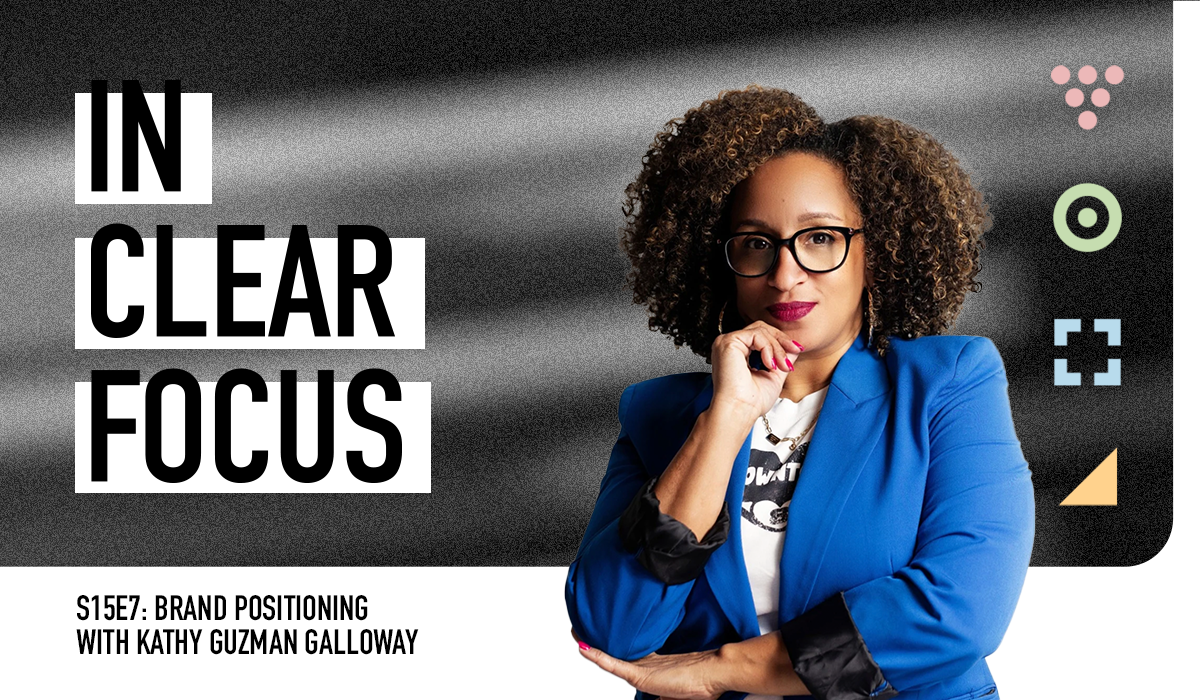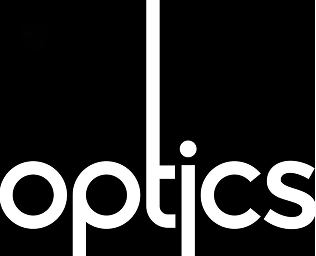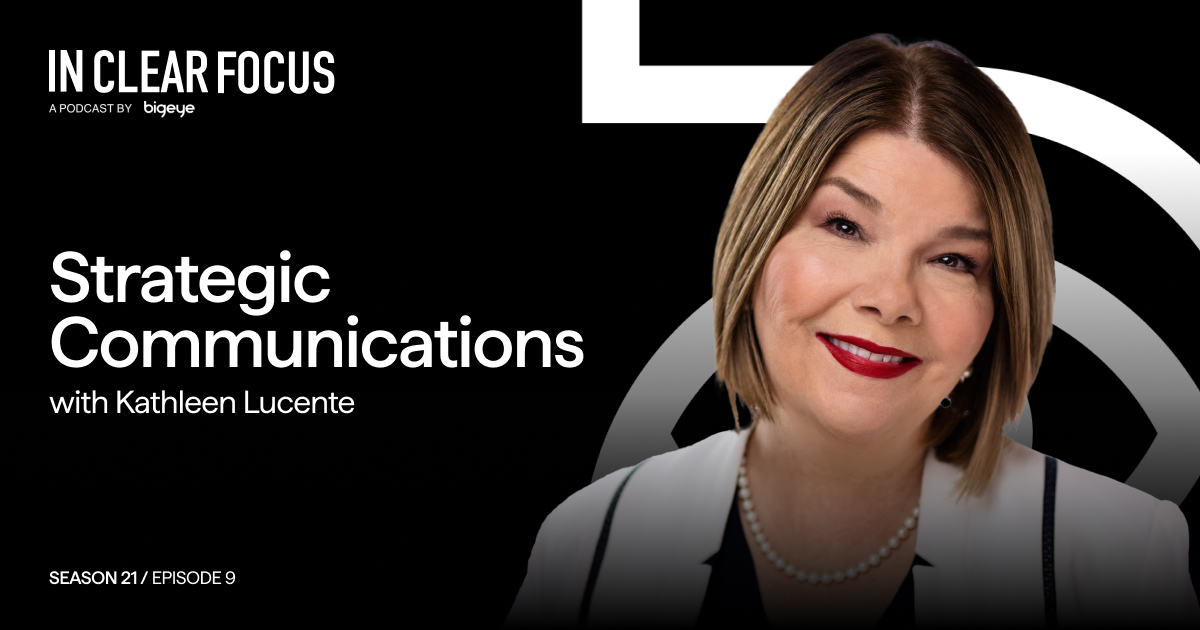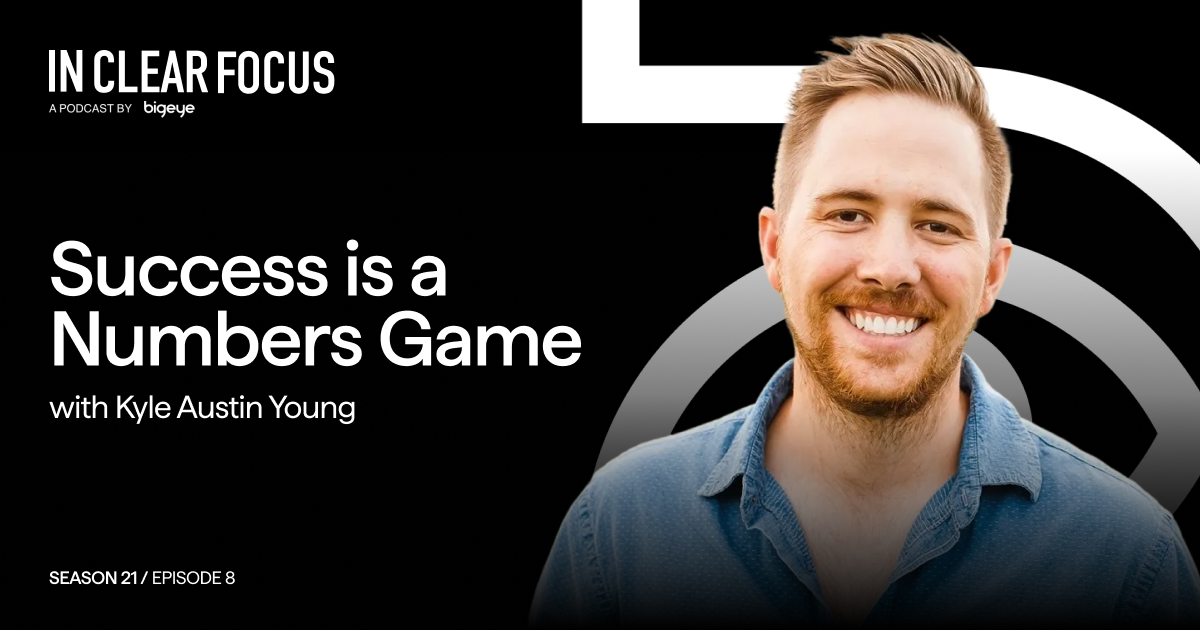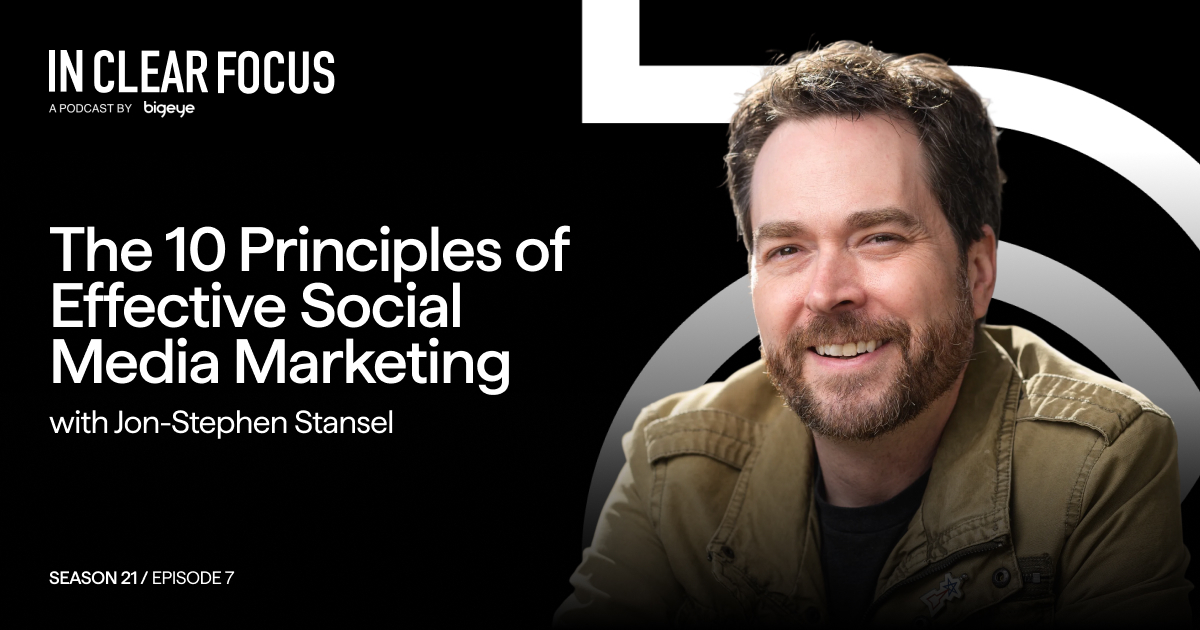IN CLEAR FOCUS: Kathy Guzmán Galloway, a seasoned CPG strategist known to her clients as The Clarity Wizard, shares insights on her unique brand positioning framework and the impact of consumer research on effective brand strategy. Kathy discusses the role of multicultural marketing in brand positioning and future trends shaping the CPG space. Learn how brand positioning can help tell compelling brand stories and stay relevant in today’s rapidly changing consumer landscape.
Episode Transcript
Announcer: Attention, marketers! Get ready to transform your advertising strategies with Bigeye’s new 2024 National Research Study, Retail Revolution. This in-depth report explores the rapidly changing retail landscape. You’ll find valuable consumer insights across key areas, including shopping behaviors, direct-to-consumer brands, sustainability, brand collaborations, retail advertising, influencer marketing, and AI. To download your free copy of Bigeye’s Retail Revolution, go to bigeyeagency.com/retail-revolution. That’s bigeyeagency.com/retail-revolution. Reshaped by technological advancements, new consumer preferences and global events, Bigeye’s Retail Revolution is your guide to the future of retail marketing and advertising. Join the Retail Revolution!
Adrian Tennant: Coming up in this episode of IN CLEAR FOCUS:
Kathy Guzmán Galloway: We’re asking people to make a change in behavior. Doesn’t matter what you’re selling, you are asking people to do something they’re not doing today. You cannot do that if you don’t understand them. At every level, positioning without consumer research is actually not a thing.
Adrian Tennant: You’re listening to IN CLEAR FOCUS, fresh perspectives on marketing and advertising, produced weekly by Bigeye, a strategy-led, full-service creative agency growing brands for clients globally. Hello, I’m your host Adrian Tennant, Chief Strategy Officer. Thank you for joining us. A strong brand position clarifies what makes a company or product unique, relevant, and compelling to target consumers, forming the strategic foundation upon which effective marketing and advertising are built. Defining a brand’s positioning is critical in highly competitive categories such as consumer packaged goods. Our guest today is an expert in helping consumer brands clarify their positioning to drive business growth. Kathy Guzmán Galloway is a seasoned CPG strategist and positioning expert with over 20 years of experience. Known to her clients as the Clarity Wizard, Kathy has helped hundreds of organizations, including NatureMade, Lays, and Chiki Chiki Boom Boom, increase revenue and reduce risk by refining their brand positioning. Kathy started her CPG career at PepsiCo, where she learned firsthand the value of research and turning consumer insights into strategic actions. To discuss her unique approach to brand positioning, I’m delighted that Kathy is joining us today from Dallas, Texas. Kathy, welcome to IN CLEAR FOCUS!
Kathy Guzmán Galloway: Thank you. Excited to be here. Appreciate it.
Adrian Tennant: Well, Kathy, you have two decades of experience in CPG brand strategy. Can you tell us a bit about your journey in the industry and how you came to focus specifically on brand positioning?
Kathy Guzmán Galloway: Yes, I’d love to tell you a little bit about that. I started my career at PepsiCo in the world of snacks and beverages and had a chance to really learn a lot about foundational classically managed brands. And it was a great experience to really kick me off in the right direction. And that was really my first exposure to brand positioning. One of the first projects I’d ever done was on the Lays brand, this gigantic potato chip brand in the United States. And it really just opened my eyes to what it means to be focused and clear, even when household penetration is above 80% and really unique experience that way. And then throughout the rest of my corporate career, I worked in milk business. I worked in beauty and hair care. And eventually decided that I wanted to start consulting. And all of those experiences really led me to find a place where I felt I could focus in on my expertise, the things that I knew I could do well, and that the world needed, which ultimately turned out to be brand positioning. The last 11 years that I’ve been consulting had a chance to work with brands of all sizes. I do quite a bit of mostly volunteer work with startup brands and all the way up to Fortune 1000 brands. And they each have their own unique challenges when it comes to brand positioning. But I found that no matter what the engagement was or why the brand team called me in to help support them, we always found our way right back to brand positioning. and a skill that I loved to work on and continued to develop. So it became really easy in the last year or so to rebrand my company and in many ways reposition myself as an expert on brand positioning based on all of that experience.
Adrian Tennant: Perfect. Now, if anybody’s unfamiliar, can you tell us – what is brand positioning?
Kathy Guzmán Galloway: Great question. There are many ways to describe brand positioning. At the end of the day, it’s about a promise you’re making to a consumer or to an end user if it’s a customer or client. The brand promise is how I expect as a user and someone who is engaged with your brand How I expect you to behave for me? What are you going to be delivering for me? What does it look like? What should that experience feel like? What are the emotions that come associated with that brand? And it’s an imprint that we hope to make in the consumer’s mind that lives with them even beyond the engagement of the brand. And ultimately brand positioning gets us to that brand promise that lives on forever.
Adrian Tennant: What are some of the most common limitations or misconceptions in how brands approach their positioning?
Kathy Guzmán Galloway: Unfortunately, there are many brands that look at brand positioning as a very transactional definition, meaning the consumer shows up looking for a loaf of bread. I’m going to provide them a loaf of bread that has all the right qualities they’re looking for. But in reality, brand positioning lives well beyond the product experience. Brand positioning has to start at the master brand level, particularly for those brands that have a portfolio of products, brands whose portfolio goes beyond one category. I often like to rely on Lays because I spend so much time on that brand to illustrate the point in that The Lay’s brand has a positioning at the master brand or at the trademark level. And then they’ve got a range of products in the portfolio that are quite different from each other. So classic potato chips versus Lay’s kettle cooked potato chips versus Lay’s stacks. And some of the more recent innovation that are more in like a 3D format. Those are all talking to different occasions. different need states, and sometimes different users, right? If mom is buying classic potato chips for our Saturday afternoon lunch, she may also be buying flaming hot potato chips for lunch boxes. and also maybe buying stacks in the canister, which is the Pringles competitor for on the go to have in the car. And so she may be buying all three of those, but the users may be different. The occasion may be different. And so understanding how they all live, not only individually, but also together as an ultimate brand that needs to survive well beyond that one product experience that often gets lost in the work of brand positioning, unfortunately.
Adrian Tennant: Well, Kathy, you’ve devised a unique brand positioning framework. Could you break down the key elements and how they work together?
Kathy Guzmán Galloway: Yes, I’d love to. I’ve been working with these concepts for a long time. It wasn’t until I started teaching and mentoring startup founders that I realized that there isn’t an intuitive, clear way to talk about some of these things. In particular, topics like mission, purpose, values, and their relationship to brand positioning seem to just be a cloud of lack of understanding. So before I started working with startup founders, and even still today, my client target are brands that are around 100 million to just under 1 billion. Those brands typically have done some preliminary work on things like purpose, mission, etc. But they don’t often bring them all together. Yet working with them felt a little easier to talk about how we bring them together. It wasn’t until I started talking to startups that I realized, hey, there’s probably a way to lay this out that just makes it more intuitive for anyone that is doing this work. And so the framework takes purpose, which is what is driving us to do this work. And by the way, I don’t care what you are selling or who you’re selling it to. You absolutely have a purpose. That does not necessarily mean it requires a social mission. We could have a whole entire episode just about that. But we’ll start with purpose. That then leads to mission, which is literally what are we going to do in order to live into our purpose? That would then lead into brand positioning. And I often talk to brands about particularly at the master brand level, your products are ultimately a tool that helps you live into your purpose. So products on their own, absolutely. And the relationship with the consumer is the end all and be all of that immediate relationship. But actually that product creates the connection point that can go well beyond what the product experience is. And so in that way, the product becomes a tool. That would be then your positioning. That would then be surrounded by the two last components, which are our values. Our values are about how we behave in the world, how we talk, what we think is right, that dictate the choices we make as a brand. And then finally is brand identity. Often we think about brand identity purely as visual identity, but actually identity is much bigger and broader than that. And we’ll rely on a creative agency to help bring that identity to life as we should. We are not designers. Typically brand owners are not designers, but that agency also needs some clear guidance from us. to ensure that you’re getting back the work that you expect to get. And that’s the work you would do in identity. So all of those pieces come together, purpose, mission, positioning, values, and identity to create what I call the heart of the brand. These are the things we are bringing to the world that we will be rewarded for and we measure elsewhere, but what we put out into the world. And that ultimately is the brand fundamentals framework.
Adrian Tennant: Do elements of your framework change based on whether you’re working with a new market entrant or an existing well-established
Kathy Guzmán Galloway: They don’t. The parts of fundamentals always remain the same. The ingredients will change, right? So we’re still making the same cake. Is it a chocolate cake? Is it a vanilla cake? Is it a strawberry cake? And so where the world influences those pieces is at every point. It influences purpose, mission, positioning, values, and identity. And as such, they will evolve over time. Purpose, not as quickly. It may evolve in language, but in intention, likely to remain the same. Mission will evolve as you make progress. Positioning will evolve as the consumer evolves. It is a necessary process. You’re constantly looking at positioning because the consumer is constantly changing. Values may evolve as you discover that there’s something more or less important in one category or one industry than another. And then, of course, identity will follow all four of those pieces. So it’s less about what is included and more about how those come to life based on the industry, the brand, the category.
Adrian Tennant: Kathy, what roles do audience research and consumer insights play in developing brand positioning?
Kathy Guzmán Galloway: 100% of a role. 100% of a role. So even something like purpose that is very much a reflection of an internal desire and an internal drive has to reflect on the world at large in order to come up with the tension that makes our drive relevant. It’s not enough to say, I want to help kids in Africa have access to water? Why? Why do you care? There are many people working on access to water in Africa. Why you are the one to drive this issue and that tension, that understanding of the world in which we live is what would influence that. When we talk more specifically about consumer research, which is typically what brand owners are talking about, it most certainly would influence the brand positioning. And everything about brand positioning has to start with that. Why is this person looking for an alternate solution? And they may not even be looking. Why does this person need this alternate solution? What do we know about them as a human? in that category, in that experience that makes it relevant to us as a brand. And then as we start to articulate what we offer, how are they reacting to that? That also requires consumer research. What is it that they see in us that is relevant to them, exciting to them? And what is the language we can use to better connect with them? At the end of the day, we’re asking people to make a change in behavior. Doesn’t matter what you’re selling, you are asking people to do something they’re not doing today. You cannot do that if you don’t understand them at every level. And so positioning without consumer research is actually not a thing. That’s just you talking to yourself in a room.
Adrian Tennant: Great. Beyond understanding the target consumer, what other factors are critical for brands to consider when crafting their positioning?
Kathy Guzmán Galloway: Yes, a few things. So clearly we need to have a deep understanding of the category that we play in and the competitors in that space. So we need to know what we’re up against in the context of a point of purchase. But beyond that, we also need to understand the alternatives that are not necessarily products. Are they making this at home today? Are they finding alternates that don’t quite deliver are doing a good enough job? What are those accommodations that the consumer or the industry or the category is making because there isn’t a solution in place? We need to understand that. We also need to understand our own desire for the impact we’re making, which is where the framework comes into play. So positioning falls flat if you’ve not defined the purpose and the mission, the values and the identity for your business. Because the values, as an example, if one of your values are that we commit to fair hiring and compensation practices, doesn’t feel like that would apply in brand positioning. But as a matter of fact, it would because it will influence the kind of ingredients, the way that you would package, how you market, the way that you hire and the way that you engage with vendors. And so even something as small as that would absolutely impact the way that you articulate what you are bringing to the table. So there’s also that need for us to look inward as well as looking outward to be able to fully articulate a brand positioning statement.
Adrian Tennant: Let’s take a short break. We’ll be right back after this message.
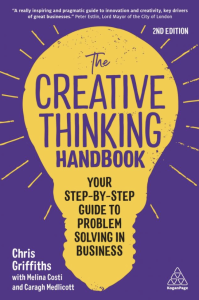 | Adrian Tennant: Each month, in partnership with our friends at Kogan Page, the Bigeye Book Club features books by industry thought leaders. Our selection for June is The Creative Thinking Handbook: Your Step-by-Step Guide to Problem-Solving in Business. Now in its second edition, this comprehensive guide is packed with advice, practical tools, useful templates, and a proven problem-solving model called the Solution Finder. Following the book’s step-by-step strategy will help unlock your creative potential, generate original ideas, and find innovative solutions to business challenges. As an IN CLEAR FOCUS listener, you can save 25% on a copy of The Creative Thinking Handbook when you order directly from the publisher at KoganPage.com. Just enter the exclusive promo code BIGEYE25 at checkout. The code is valid for all Kogan Page titles, including pre-orders and their paperback and e-book bundle offers. Shipping is always free to the US and UK when you order directly from Kogan Page, and it also supports the authors. |
Adrian Tennant: Welcome back. I’m talking with Kathy Guzmán Galloway, CEO of The Clarity Wizard. We’re discussing her unique approach to brand positioning and how consumer insights drive effective brand strategy. Do you have any tips on how legacy brands can re-evaluate and refresh their positioning to stay relevant to today’s consumers?
Kathy Guzmán Galloway Yes, I think legacy brands in particular have really the biggest challenge when it comes to brand positioning, because particularly in the past, and in the past I’m thinking 30 years and longer than that. I think we were looking at brand positioning as a moment in time. The world did not change that fast. So you could do brand positioning work one year, feel good about where you are, and not look at it again for five more years. Maybe even 10 years because the competitive set doesn’t change that much. The consumer doesn’t change that much. That is no longer the case. It was true before COVID and since COVID it has become ridiculously true. Like so true that it’s almost a daily change. Consumers are changing on the daily and so understanding where the world is moving is the most important thing that a legacy brand can do, particularly because they are often handcuffed by long lead times in executing anything. And so you can’t wait to discover that, oh man, I’m losing a ton of share in XYZ that you’ve already lost. By the time you’ve learned what is happening and start to try to solve for that, the issue is long, far and away from you. And so remaining on top of insights and consumer trends consistently is really the only way to stay ahead of that. So that would be my advice to legacy brands. If you don’t have a budget already for consumer research that keeps you on top of what’s happening with the consumer every single year, you’re already behind the ball.
Adrian Tennant: Kathy, could you share a couple of case studies with clients you’ve helped to illustrate how you clarified their positioning and its impacts on their businesses?
Kathy Guzmán Galloway: Yeah, absolutely. I’ll give you two examples on the extreme. On the one end, I’ll talk about a large, established legacy brand, if you will, been around for over 140 years. So been around forever and for a long time were anchored in the idea that parents were looking for healthier products for their kids. I want to give my kids something that I can feel good about, but that they also want to have, because otherwise I’m wasting my money, right? They’re not going to eat the carrots. OK, I’ve just wasted $3 on the carrots, right? So I need to provide this parent healthy products that the parent feels good about, but also delicious and fun and tasty products that kids will want to have. That worked phenomenally well for 30, 40, 50 years that they’d been talking about that. And in the last three or four years what we learned in working with them last year is really when we did the bulk of this positioning work and working with them what we discovered is that there’s actually a nuance to that that we just hadn’t considered before because every time you ask a parent Is this still true? Do you want to give your kids something healthy that they also will love? The answer is always yes. So what’s the problem? I don’t understand what I’m doing wrong. What needed to happen was to start to peel the onion and ask questions about the choices that they’re making that seemingly feel like they fit the objective. All of these seem fun for kids, all of these seem healthy, how are you choosing between them? And really digging, I’m overly simplifying the process of getting to the insight, by the way, but in the process of peeling that onion and asking those questions, we uncovered something that in retrospect felt so obvious is that brands are always claiming things. I’m natural, I have no artificial this, we produced it in such and such way, but how do I know this to be true? As a consumer, how do I know? Everywhere I turn, every product on the shelf has a claim like this. How do I know this is true? And that became the new guiding insight that there’s this mistrust of brands in a way that is unique and different than it’s been before. It’s not that, hey, this big conglomerate is just trying to take my money and run away. It’s more that I’m seeing something on a package and I just don’t know if that is true. And so the effectiveness of that message isn’t as impactful anymore. And that meant that the team had to really dig in and start to think about, well, how do we then talk about this in that context that makes a difference? So that’s one example of a legacy brand. On the other side, I’ll give you the example of a very young brand I’m working with. They’re under $10 million in revenues, and they are in the beverage space. And the questions that we were working through there on brand positioning was related to non-alcoholic beverages, which are exploding. There’s so many of them. There’s a ton of stuff there. And what we discovered in that process of understanding why their particular product was not resonating with those consumers as well as we hoped, was actually that we were just talking to the wrong person. And this is actually something I’ve hypothesized for a long time, was excited to get to work with them and validate that the only people talking about non-alcoholic beverages really is the industry. We’re talking to ourselves. Consumers are not really thinking about it that way. There are certainly consumers who don’t drink alcohol. They’ve already figured what this looks like. They know what beverages they’re getting. Then there are consumers who are drinking alcohol. who either want to sometimes not always that was the key sometimes and actually very few times want to walk away from the alcohol and I need something different or even while I’m drinking I’ve just had too many margaritas I just want something different I need a little break because of whatever is happening experientially in my body. And so the pivot was, it’s not necessarily about moderation. And this was true for them. I will asterisk that depending on what you’re selling, it will be different for you. But for them, it wasn’t necessarily about moderation. It was about variety. And so in the way that we were talking about it, it didn’t resonate because most of the people who are drinking alcohol today, which are mostly over the age of 30, they’re not really talking about moderation in such a grand scale that I need a standalone unique product for that. I’ve got sodas and juices and sparkling waters that are doing that. And so talking about that is just opening up a wide range of competition that gets away from us. So really understanding that audience is what made the difference and how we talked about that for them. So really different experiences, but ultimately gets down to the consumer. What is it that they want? How has the world changed for them? What is it that they’re looking for?
Adrian Tennant: You describe yourself as an Afro-Latinx, New Jersey native, living in Texas, and a proud Dominican-American. Kathy, how do you typically advise brands to take a multicultural approach to their positioning and marketing?
Kathy Guzmán Galloway: Yes, thank you for that. I’m actually quite proud of all of those descriptors. And actually, each one of them play a really big role in who I am and my personality. And the more you get to know me, the more you find, especially the Dominican Jersey part, really starts to come to life. For brands that are not thinking about multicultural marketing, you’re already losing. And I say that because there was a time when multicultural audiences were growing and they represented a growth opportunity. And the time I’m thinking about are the nineties, early two thousands. There was a lot of talk about that. The horse has come into the barn. Like we we’re here. It’s happened. It’s done. Particularly if you are talking to anyone who is a parent or anyone under the age of 30, the idea that you need to do something unique for a multicultural audience is not a thing anymore. They’re all multicultural. Period. The entire audience is multicultural. So it’s almost like the conversation about omni-channel, right? There was a time where we were talking about, oh my God, the consumer is going online. You need to have an omni-channel perspective. That’s not a thing anymore. Omni-channel, we don’t even need the word because it is what we’re living today. I think it’s the same thing with multicultural. And so my advice comes right back to the same thing. Who’s your audience? Regardless of their demographic, whether it’s a white person in Omaha or a black person in Atlanta or a Mexican-American in L.A., you got to spend the time with them. You got to understand the audience and how they engage with the category. There is an asterisk, however, to say that when and if you need to get to learn about these consumers in a meaningful way, It’s important to do it in a way that respects them and allows you to get real insights. I’ll give you a very brief example of that and say there’s so much more to this. If you are going to do, whether it’s one-on-one interviews, focus groups, ethnographies, where you are face-to-face with a consumer. And that consumer is not of the same race as you, sometimes even not of the same gender. Depending on what you are selling, you may not get the insights you think you want. Because there is some truth to being comfortable with who you’re speaking to. So if you’re talking to, as an example, women about breastfeeding, you probably don’t want to have a man talking to her about that. You probably want another woman who’s been a parent. The same is true for multicultural audiences. If you want to speak to a Mexican American in LA, you need to understand what kind of a setup you need to provide to enable that person to feel comfortable in speaking with you. Anyone who’s embarking on that, I have a number of resources and partners I work with that do really great work in that space that I’m happy to connect you with. But doing it in a traditional way without understanding that nuance of culture, you’ll actually only get to the surface and it will fall flat. So it’s an important thing to understand.
Adrian Tennant: Kathy, how does effective brand positioning impact a company’s ability to tell compelling brand stories?
Kathy Guzmán Galloway: It’s literally the end all and be all of compelling brand story. And I mean that through the lens of getting someone to engage with your brand. If the purpose of your brand storytelling is I want you to get to know us. I want you to feel excited to be part of what we are doing. And I want you to pick up one of our products and eventually be an evangelist for our brand. then brand positioning has to be at the core. Because again, we come back to the same point. Who is this person? What do they care about? And what is it about my story that will engage them? And it’s a little bit of a dance because half of who we are and what we want to bring to the table, again, back to the framework, it’s the purpose, it’s the mission, it’s our values, All of that feeds into brand positioning. And so my piece of the puzzle comes to the table in order to attract your piece of the puzzle. And so it always comes back to brand positioning. I think I need a t-shirt that says it always comes back to brand positioning.
Adrian Tennant: Love that. What are some of the most exciting or impactful trends shaping the future of brand positioning in the CPG space, would you say?
Kathy Guzmán Galloway: Yeah, I think the things I’m most excited about to jump on the bandwagon, AI, but AI in the sense that it can help speed the process of learning and iteration. in brand positioning. And so when I think about AI and some of the tools that exist now and tools that we don’t even know are coming and I can’t wait for them to arrive, the ability that they have in these large language models to synthesize and represent ideas that exist in the world that would take us forever to go get access to is such a powerful thing to help us expand our view of consumers and of the world. And then once we have a point of view and we’re starting to articulate what that is, generative AI, which I already am using for the purpose of articulating things in a different way. Because of course, everything I write, even though it’s one of the key strengths and assets I bring to the table in brand positioning, is being able to articulate a perspective It’s all clouded by my own experience, clouded by the work I did at PepsiCo. It’s clouded because my family’s from the Dominican Republic. It’s clouded because I’m a mom. It’s clouded by any number of things. And so what generative AI does is that it provides exposure to me. to versions of what I am saying that may resonate to someone unlike me. How would I say this differently? And that to me is so valuable, because again, both of these things I’m talking about, all it’s doing is speeding us through the process of getting to something more effective. So AI for brand positioning and brand communication broadly is really exciting. I cannot wait to see what that looks like in a year’s time.
Adrian Tennant: Well, you’re the mother of two girls, so do you feel a special responsibility or mission to advocate for more inclusive and culturally nuanced brand positioning?
Kathy Guzmán Galloway: Oh, that’s a great question. I feel a lot of responsibility as the author of Teenage Girls, and I might not say it as responsible for more inclusivity or cultural nuance, but what I might say is I feel responsible for helping brands figure out how to do it. I find that the brands that I attract and certainly the ones I want to work with are brands that are already aware that this is an opportunity that are already sensitive to that but often are like I just I’m not even sure what like what does that mean for me right I mean I sell laundry detergent like what Where is there a cultural nuance here, right? So having the opportunity to help them think through that, which for me starts at purpose. It always comes back to purpose and what is driving you to sell this laundry detergent? Why did you even bother either taking this job or deciding to found this company? Why are you doing this? Why are you spending your time on that? I think that to me is really where I feel like I can have an impact, a lasting impact on the world that I can be proud of. It’s to force people to start to think about purpose, mission, values in a way we really never have before when it comes to brand positioning. And that to me is powerful.
Adrian Tennant: Kathy, if IN CLEAR FOCUS listeners would like to learn more about you and your work as the clarity wizard, what’s the best way to contact you?
Kathy Guzmán Galloway: Yes, I’d love to get in touch with all of you. You can find me on LinkedIn. I post heavily and you’ll find a new newsletter that I’ll be publishing in the coming weeks. So you can just search for my name. You’ll find me there, Kathy Guzmán Galloway, but you can also find me on our website where I have some free downloads and materials for podcast listeners. You can find that at www.theclaritywizard.com forward slash podcast. Perfect.
Adrian Tennant: Kathy, thank you very much for being our guest this week on In Clear Focus.
Kathy Guzmán Galloway: Thank you for having me.
Adrian Tennant: Thanks again to my guest this week, brand positioning expert Kathy Guzmán Galloway You’ll find a complete transcript of our conversation, with links to the resources we discussed, on the IN CLEAR FOCUS page at bigeyeagency.com. Just select Insights from the menu. Thank you for listening to IN CLEAR FOCUS, produced by Bigeye. I’ve been your host, Adrian Tennant. Until next week, goodbye.
TIMESTAMPS
00:01: Introduction to Bigeye’s Retail Revolution Study
01:00: Importance of Consumer Research in Brand Positioning
04:57: Definition of Brand Positioning
05:49: Limitations and Misconceptions in Brand Positioning
07:51: Kathy’s Brand Positioning Framework
11:09: Consistency in Brand Positioning Elements
12:27: Role of Audience Research and Consumer Insights
14:24: Factors Critical for Crafting Brand Positioning
17:41: Advice for Legacy Brands on Positioning
19:35: Case Studies on Brand Positioning Impact
24:43: Multicultural Approach to Brand Positioning
28:20: Brand Positioning and Compelling Brand Stories
29:38: Trends Shaping Brand Positioning in CPG
31:45: Advocating for Inclusive Brand Positioning
33:12: Kathy’s Contact Information
